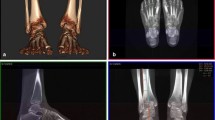Abstract
Objective
To compare the hindfoot alignment measured on standing HAV radiographs (Saltzman view) and on non-weight-bearing coronal MR images.
Materials and methods
The apparent moment arm was measured on weight-bearing conventional radiographs (Saltzman views) and on MRIs of the ankle in 50 consecutive patients (mean age, 54 years; age range, 18–77 years). The evaluation was performed independently by three readers using analogous reference points for both methods. Positive values were assigned when the deepest point of the calcaneus was lateral to the tibial axis as valgus, negative values as varus. The intertechnique agreement and correlation for the measurements performed with HAV radiographs and MRI were assessed for each reader using the Bland-Altman method and the Pearson correlation coefficient, respectively. The interobserver agreement was assessed using the intraclass correlation coefficient.
Results
The means of apparent moment arms, with the standard deviation (SD) in parentheses, of three readers were +2.0 (±8.4) mm, +1.5 (±6.6) mm and −1.4 (±8.2) mm on HAV radiographs and +4.6 (±7.4) mm, +6.3 (±5.3) mm and +5.4 (±6.4) mm on MRI. The Bland-Altman analysis found a systematic bias for all three readers, corresponding to an overestimation of measurements with MRI (systematic bias ranging from 2.6 to 4.8 mm). The intertechnique correlation was found moderate to high. The Pearson coefficients for the three readers were 0.75, 0.64 and 0.65. The interobserver agreement among the three readers was 0.72, 0.77 and 0.68 for HAV, MRI and both modalities together, respectively.
Conclusion
Hindfoot alignment can be estimated on MRI but the correlation between the values on HAV radiographs and MR images is only moderate with a tendency to increased positive values (valgization) on MR images.




Similar content being viewed by others
References
Sproule JA, Glazebrook MA, Younger AS. Varus hindfoot deformity after talar fracture. Foot Ankle Clin. 2012;17(1):117–25.
Rammelt S, Zwipp H. Corrective arthrodeses and osteotomies for post-traumatic hindfoot malalignment: indications, techniques, results. Int Orthop. 2013;37(9):1707–17.
Mäenpää H, Lehto MU, Belt EA. Stress fractures of the ankle and forefoot in patients with inflammatory arthritides. Foot Ankle Int. 2002;23(9):833–7.
Spratley EM, Matheis EA, Hayes CW, et al. Validation of a population of patient-specific adult acquired flatfoot deformity models. J Orthop Res. 2013;31(12):1861–8.
Liu H, Sugamoto K, Itohara T, et al. In vivo three-dimensional skeletal alignment analysis of the hindfoot valgus deformity in patients with rheumatoid arthritis. J Orthop Res. 2007;25(3):330–9.
Swaroop VT, Dias L. Orthopaedic management of spina bifida-part II: foot and ankle deformities. J Child Orthop. 2011;5(6):403–14.
Lamm BM, Paley D. Deformity correction planning for hindfoot, ankle, and lower limb. Clin Podiatr Med Surg. 2004;21(3):305–26.
Saltzman CL, El-Khoury GY. The hindfoot alignment view. Foot Ankle Int. 1995;16(9):572-576.
Cobey JC. Posterior roentgenogram of the foot. Clin Orthop Relat Res. 1976;118:202–7.
Frigg A, Nigg B, Davis E, et al. Does alignment in the hindfoot radiograph influence dynamic foot-floor pressures in ankle and tibiotalocalcaneal fusion? Clin Orthop Relat Res. 2010;468(12):3362–70.
Frigg A, Nigg B, Hinz L, et al. Clinical relevance of hindfoot alignment view in total ankle replacement. Foot Ankle Int. 2010;31(10):871–9.
Lamm BM, Mendicino RW, Catanzariti AR, et al. Static rearfoot alignment: a comparison of clinical and radiographic measures. J Am Podiatr Med Assoc. 2005;95(1):26–33.
Tourné Y, Besse JL, Mabit C, et al. Chronic ankle instability. Which tests to assess the lesions? Which therapeutic options? Orthop Traumatol Surg Res. 2010;96(4):433–46.
Donovan A, Rosenberg ZS. Extraarticular lateral hindfoot impingement with posterior tibial tendon tear: MRI correlation. AJR Am J Roentgenol. 2009;193(3):672–8.
Hubbard AM, Davidson RS, Meyer JS, et al. Magnetic resonance imaging of skewfoot. J Bone Joint Surg Am. 1996;78(3):389–97.
Bland JM, Altman DG. Statistical methods for assessing agreement between two methods of clinical measurement. Lancet. 1986 Feb 8;1(8476):307–10.
Mukaka MM. Statistics corner: a guide to appropriate use of correlation coefficient in medical research. Malawi Med J. 2012;24(3):69–71.
Fleiss JL, Cohen J. The equivalence of weighted kappa and the intraclass correlation coefficient as measures of reliability. Educ Psychol Meas. 1973;33:613–9.
Hirschmann A, Pfirrmann CW, Klammer G, et al. Upright cone CT of the hindfoot: comparison of the non-weight-bearing with the upright weight-bearing position. Eur Radiol. 2014;24(3):553–8.
Buck FM, Hoffmann A, Mamisch-Saupe N, et al. Diagnostic performance of MRI measurements to assess hindfoot malalignment. An assessment of four measurement techniques. Eur Radiol. 2013;23(9):2594–601.
Johnson JE, Lamdan R, Granberry WF, et al. Hindfoot coronal alignment: a modified radiographic method. Foot Ankle Int. 1999;20:818–25.
Zhang YJ, Xu J, Wang Y, et al. Correlation between hindfoot joint three-dimensional kinematics and the changes of the medial arch angle in stage II posterior tibial tendon dysfunction flatfoot. Clin Biomech. 2015;30(2):153–8.
Author information
Authors and Affiliations
Corresponding author
Ethics declarations
All procedures performed in this study were in accordance with the ethical standards of the institutional and national research committee and with the 1964 Helsinki Declaration and its later amendments. Moreover, this study was approved by the local ethics committee.
Conflict of interest
The authors declare that they have no conflicts of interest with the publication of this article.
Informed consent
Informed consent was obtained from all individual participants included in the study.
Rights and permissions
About this article
Cite this article
Büber, N., Zanetti, M., Frigg, A. et al. Assessment of hindfoot alignment using MRI and standing hindfoot alignment radiographs (Saltzman view). Skeletal Radiol 47, 19–24 (2018). https://doi.org/10.1007/s00256-017-2744-0
Received:
Revised:
Accepted:
Published:
Issue Date:
DOI: https://doi.org/10.1007/s00256-017-2744-0




